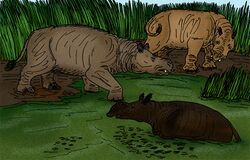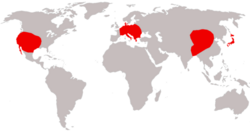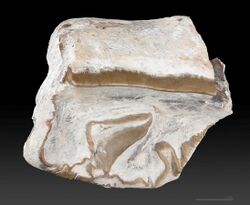Biology:Amynodontidae
| Amynodontids | |
|---|---|

| |
| Scientific classification | |
| Domain: | Eukaryota |
| Kingdom: | Animalia |
| Phylum: | Chordata |
| Class: | Mammalia |
| Order: | Perissodactyla |
| Superfamily: | Rhinocerotoidea |
| Family: | †Amynodontidae Scott & Osborn, 1883[1] |
| Type genus | |
| †Amynodon | |
| Genera[2] | |
|
See text | |

| |
| Range of Amynodontidae based on fossil record | |

Amynodontidae ("defensive tooth")[4][5] is a family of extinct perissodactyls related to true rhinoceroses. They are commonly portrayed as semiaquatic hippo-like rhinos[6][7] but this description only fits members of the Metamynodontini; other groups of amynodonts like the cadurcodontines had more typical ungulate proportions and convergently evolved a tapir-like proboscis.
The Greek name of the family describes their tusks, derived from enlarged canine teeth. Odd-toed ungulates are herbivores, so these tusks would have been used either to deter or defend against predators (as suggested by the name) or perhaps in fights among males.[8]
Their fossils have been found in North America, and Eurasia ranging in age from the Middle Eocene to the Early Oligocene, with a single genus (Cadurcotherium) surviving into the Late Oligocene in South Asia (Pakistan).[9] The genus Metamynodon may have survived into the early Miocene.[citation needed]
Taxonomy
†Amynodontidae
- Subfamily Amynodontinae
- Tribe Cadurcodontini
- Genus Cadurcodon[10]
- Genus Lushiamynodon[10]
- Genus Sharamynodon[10]
- Tribe Metamynodontini
- Tribe incertae sedis
- Genus Amynodon[10]
- Tribe Cadurcodontini
- Subfamily incertae sedis
References
- ↑ Scott, W. B.; Osborn, Henry F. (1883). "On the Skull of the Eocene Rhinoceros, Orthocynodon, and the Relation of this Genus to other Members of the Group". Contributions from the E. M. Museum of Geology and Archæology of Princeton College 3: 1–22.
- ↑ McKenna, M. C.; S. K. Bell (1997). Classification of Mammals Above the Species Level. Columbia University Press. ISBN 0-231-11012-X.
- ↑ Marsh, O. C. (1877). "Notice of some new Vertebrate Fossils". The American Journal of Science and Arts. Ser. 3 14 (81): 251–252. https://www.biodiversitylibrary.org/page/36333917.
- ↑ "Glossary | Perissodactyl". http://research.amnh.org/paleontology/perissodactyl/concepts/glossary#amynodon.
- ↑ https://logeion.uchicago.edu/%E1%BC%80%CE%BC%CF%8D%CE%BD%CF%89
- ↑ Savage, RJG; Long, MR (1986). Mammal Evolution: an illustrated guide. New York: Facts on File. pp. 194. ISBN 0-8160-1194-X. https://archive.org/details/mammalevolutioni0000sava.
- ↑ Palmer, D., ed (1999). The Marshall Illustrated Encyclopedia of Dinosaurs and Prehistoric Animals. London: Marshall Editions. pp. 264. ISBN 1-84028-152-9.
- ↑ "Horns, Tusks, and Flippers: The Evolution of Hoofed Mammals". http://www.rhinoresourcecenter.com/pdf_files/141/1415340780.pdf.
- ↑ Wall, William P. (1989). "The phylogenetic history and adaptive radiation of the Amynodontidae". in Prothero, Donald R.; Schoch, Robert M.. The Evolution of perissodactyls. Oxford University Press. ISBN 9780195060393.
- ↑ 10.00 10.01 10.02 10.03 10.04 10.05 10.06 10.07 10.08 10.09 10.10 10.11 Averianov, A.Expression error: Unrecognized word "etal". (2017). "A new amynodontid from the Eocene of South China and phylogeny of Amynodontidae (Perissodactyla: Rhinocerotoidea)". Journal of Systematic Palaeontology 15 (11): 927–945. doi:10.1080/14772019.2016.1256914.
- ↑ von Koenigswald, W.Expression error: Unrecognized word "etal". (March 2011). "Diversity and Evolution of Hunter-Schreger Band Configuration in Tooth Enamel of Perissodactyl Mammals". Acta Palaeontologica Polonica 56 (1): 11–32. doi:10.4202/app.2010.0021.
- ↑ Huang, X.; Wang, J. (January 2001). "New materials of tapiroid and rhinocerotoid remains (Mammalia, Perissodactyla) from the Middle Eocene of Yuanqu Basin, Central China". Vertebrata PalAsiatica 39 (3): 197–203. https://europepmc.org/article/cba/349802. Retrieved 14 August 2020.
- ↑ Antoine, P.Expression error: Unrecognized word "etal". (2003). "Early rhinocerotids (Mammalia: Perissodactyla) from South Asia and a review of the Holarctic Paleogene rhinocerotid record". Canadian Journal of Earth Sciences 40 (3): 365–374. doi:10.1139/e02-101. Bibcode: 2003CaJES..40..365A.
- ↑ 14.0 14.1 Wall, W.P.; Manning, E. (July 1986). "Rostriamynodon grangeri n. gen., n. sp. of amynodontid (Perissodactyla, Rhinocerotoidea) with comments on the phylogenetic history of Eocene Amynodontidae". Journal of Paleontology 60 (4): 911–919. doi:10.1017/S0022336000043079. Bibcode: 1986JPal...60..911W.
Wikidata ☰ Q2745380 entry
 |


